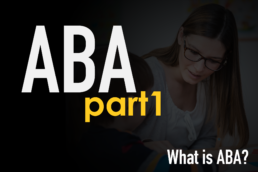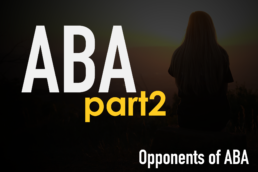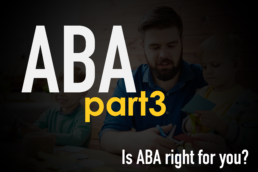Applied Behavior Analysis (part 2 of 3) – Opponents of ABA
Applied Behavior Analysis (part 2 of 3) – Opponents of ABA
“ASAN’s objection is fundamentally an ethical one.”
The stated end goal of ABA is an autistic child who is “indistinguishable from their peers”—an autistic child who can pass as neurotypical. We don’t think that’s an acceptable goal. The end goal of all services, supports, interventions, and therapies an autistic child receives should be to support them in growing up into an autistic adult who is happy, healthy, and living a self-determined life.
— Julia Bascomb, Deputy Director of the Autistic Self-Advocacy Network (ASAN) in the US.
Some who are opposed to ABA would say that the premise behind “behavioral therapies” like ABA is to teach autistic individuals to suppress autistic traits and reinforce “neurotypical” (normal) traits in an effort to “normalize” an autistic individual.
As someone who is not autistic, it would be easy for me to assume that those who are autistic would see the suppression of their autism as a good thing. Many people like me (not autistic) would agree.
Many people would be wrong.
Though there are some who have said that their autism is hindering to them, the vast majority of autistic adults I have encountered actually celebrate their autism as a valuable part of humanity’s genetic legacy, much the same way some people view their skin color. They view autism as a neurological difference, in need of understanding and acceptance, not a disease that needs to be fixed or cured.
Opponents of ABA would say that if the premise of any “treatment” is to eliminate signs of autism, it is essentially eliminating “who they are.”
So attempts to fix autistic individuals to appear to be “normal” would be in direct opposition to that sentiment. Opponents of ABA would say that “normalizing” the person to not appear to have autism is not only counter to who they are as a person, it can actually be extremely harmful to them.
Many of those who went through ABA now claim to have PTSD from it.
This opposition comes from a variety of people within the Neurodiversity Movement, spearheaded mostly by autistic adults, many who experienced ABA firsthand. They not only oppose the techniques used as “therapy,” but in the actual fundamentals on which ABA was founded, and the continued use of those principles in ABA “therapy” today.
To better understand the opposition to ABA, you need to understand the history behind it.
ABA was first developed in the 1960s by Psychologist Dr. O Ivar Lovaas. His studies indicated that many children who received early intensive ABA made dramatic gains in development. Lovaas also disseminated ABA widely through intervention manuals, educational films, and public speaking. It was formed from the branch of psychology known as Behaviorism.
Behaviorism (popularized in the 1950’s by Dr. Skinner and Pavlov training animals) attempted to understand human beings by looking only at their behavior and dismissing all internal experience, that is, thoughts and feelings.
In 1974, Dr. Lovaas gave this interview about his work with autistic individuals. Here is an excerpt…
…you start pretty much from scratch when you work with an autistic child. You have a person in the physical sense — they have hair, a nose and a mouth — but they are not people in the psychological sense. One way to look at the job of helping autistic kids is to see it as a matter of constructing a person. You have the raw materials, but you have to build the person.“
Dr. Lovaas’ view basically dehumanized autistic people and broke them down into different sets of behaviors which needed to be controlled.
Much of the pioneering work was trial and error. And unfortunately, many of the “trials” left permanent scars on those people being “built.”
Barbarous forms of “treatment” emerged. Electroshock therapy. Physical abuse. Screaming and yelling at the person as an intervention. “Therapists” would basically try to scare the autism out of these CHILDREN with the threat of pain or violence.
Dr. Lovaas looked back on one particular “case” of a girl who would constantly hit herself (self-harm), where he basically beat her until she stopped.
…At first I thought, “God, what have I done,” but then I noticed that she had stopped hitting herself. I felt guilty, but I felt great. Then she hit herself again and I really laid it on her. You see, by then I knew that she could inhibit it, and that she would inhibit it if she knew I would hit her. So I let her know that there was no question in my mind that I was going to kill her if she hit herself once more, and that was pretty much it. She hit herself a few times after that, but we had the problem licked.”
It seemed autistic individuals were basically treated like wild animals that needed to be broken and tamed into submission. How could that be the basis of any sort of intervention involving human beings? Why would we want to build off of that foundation?
Simple answer? It worked. (according to psychologists)
In the 1960s, when Dr. Lovaas began studying autism, the prevailing Freudian view rooted the condition in neurosis. Autistic children, if they were treated at all, were given psychotherapy, to little discernible effect. Others, including many of Dr. Lovaas’s early research subjects, were misdiagnosed as schizophrenic or “mentally retarded” and consigned to institutions.
Dr. Lovaas was the first researcher to suggest that for at least some children, autism is treatable. His work came to wide attention in 1987, when he published a scholarly article titled “Behavioral Treatment and Normal Educational and Intellectual Functioning in Young Autistic Children.”
In it, Dr. Lovaas reported that after rigorous training, some autistic children had been able to catch up to their peers and function in conventional classrooms.
Today there are literally dozens of offshoots of ABA, using its basic premise. ABA has evolved into many different forms of therapy including Pivotal Response Treatment (PRT), Verbal Behavior (VB), Early Start Denver Model (ESDM), and many other forms of behavioral intervention which don’t involve physical or verbal abuse.
The methods used in ABA today vary as much as the Autism Spectrum itself. Most uses of aversive reinforcement methods, which include electric shocks, are generally not considered acceptable or indeed even ethical anymore, but some say that it still happens.
According to one former ABA therapist “there are plenty of concerns that Autistic people and their allies have raised about the ABA they experienced.” This is by no means an exhaustive list, but some further concerns of current ABA practices include: (I’ve paraphrased below).
Methods some ABA practices still use, according to some autistic adults:
- “Quiet hands/body” – (no “stimming”)
- Physical restraint
- Yelling and/or screaming to stop a behavior
- “Forced” prolonged eye contact
- Withholding a beloved object until a proper behavior is performed
- Withholding affection until a proper behavior is performed
- Corporal punishment and physical abuse
- Sprayed with spray-bottles as punishment
- Forced personal interaction
- All decision-making abilities removed
- “Planned” Ignoring of obvious signs of distress
- “Electroshock” therapy (exactly what it sounds like) – which apparently still happens today.
The reward/consequence-based methodology used to coerce those subjected to it is essentially forced compliance, which some would argue, is-in fact, still little more than dog training.
Some supporters of ABA would argue that ABA therapy is not the same as what others have experienced and that ABA by and large has helped their children tremendously. You hear a variety of responses.
OUR ABA isn’t like that. My child loves his/her therapist. They’ve gained so many skills since we started.”
This is often followed by giving a list of things the child can now do…. sit still, talk, interact with peers, etc. And these changes have occurred, according to the parents, as a result of the child having been in ABA therapy.
And maybe that’s true… But opponents of ABA would contend that they may ALSO acquire those skills through alternative therapies or through natural development and that they also risk long-term damage by being forced to inhibit natural tendencies and being constantly compelled to follow “acceptable” neurotypical behavior, as they say is done with ABA.
This recent article by another former ABA therapist details out how she used to “unknowingly abuse children” by basically teaching them that…
…[ABA] is abuse because you are teaching the child that the only way that they will be tolerated is if they pretend to be like everyone else. They must sacrifice 40 hours a week instead of playing because there is something “wrong” with them which they have to spend all day everyday trying to fix. This not only gives the child internalized ableism, but also forces the child to move, communicate, play, and socialize in ways that are unnatural, uncomfortable, and often painful in the hopes that they will possibly not be treated poorly by their so-called peers. It is an act that often results in autistic burn-out later in life.
If “indistinguishability” is the end, what is the means to that end?
Compliance. This is possibly the most abusive part of ABA (and again, I’m talking about the ‘playful,’ ‘fun,’ ‘positive reinforcements only’ kind of ABA that Timmy just loves!) Timmy might be laughing. He might really love those gummy bears, or Thomas the Train. He might even genuinely love his therapist & have fun playing during the 15 minute breaks he gets each hour. But guess what? It’s still abuse.
Timmy is being taught that his body is not his own. Timmy is learning that he has to ‘earn’ access to his own belongings. Then when the therapist leaves, his favorite things are stored away until the next session. I don’t doubt that Timmy is having fun in the moment. The kids I worked with often seemed to be having fun. But the thing is, a lot of this abuse takes place on a subconscious level. The child might not even realize he’s being abused because he’s distracted by candy, or balloons. But there is a power imbalance. And little Timmy’s brain is picking up on all of this and filing it away.
- People with more power than me can force me to do whatever they want
- Nobody, not even my parents will come to my defense
- Other people are in charge of my body
- I’m not allowed to say no, or protest
- It’s OK for people to physically move me if I’m not doing what they want me to do
- If I am having a hard time, adults will ignore me instead of helping me; they don’t care
- My parents must hate me too because they won’t even give me a break (a big deal is made in ABA about ‘consistency’ and making the parents and everyone the child is around use ABA on them in the off hours too)
- I am the sum of my behaviors, I have no inherent value”
Since almost every doctor or pediatrician is quick to recommend ABA, many are under the impression that ABA is “all we have” to help their autistic loved ones. Such is not the case.
There are many other interventions which are not compliance-based. Alternatives include:
Music Therapy
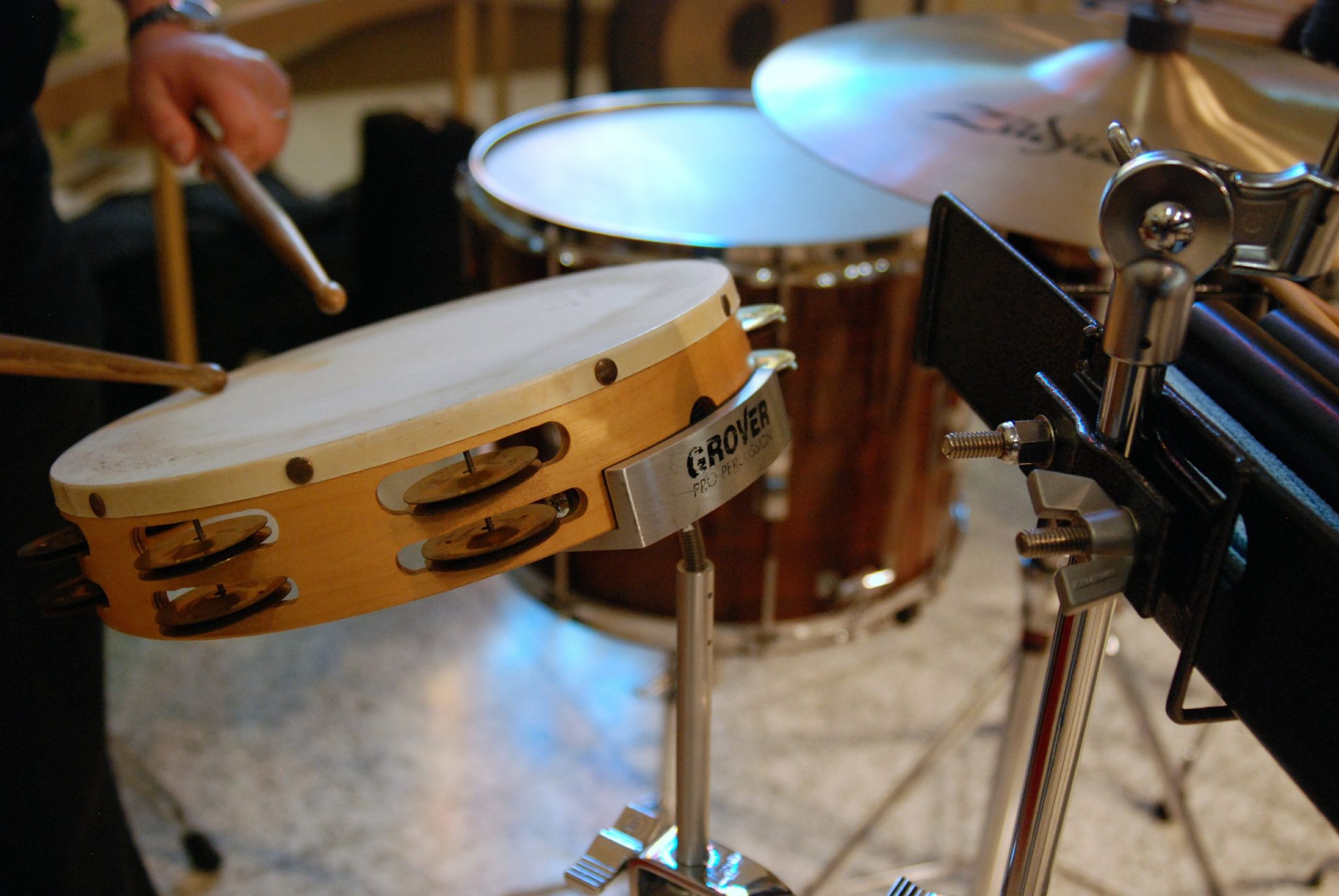
Music Therapy
“Music therapy provides a unique variety of music experiences in an intentional and developmentally appropriate manner to effect changes in behavior and facilitate development of skills….Music is a very basic human response, spanning all degrees of ability/disability. Music therapists are able to meet clients at their own levels and allow them to grow from there. The malleability of music makes it a medium that can be adapted to meet the needs of each individual. Music is motivating and enjoyable. Music can promote relatedness, relaxation, learning, and self-expression. Music therapy addresses multiple developmental issues simultaneously. Music therapy can provide success-oriented opportunities for achievement and mastery. The structure and sensory input inherent in music help to establish response and role expectations, positive interactions, and organization.” – from www.musictherapy.org (pdf file)
Art Therapy

Art Therapy
Art Therapy is an integrative mental health and human services profession that enriches the lives of individuals, families, and communities through active art-making, creative process, applied psychological theory, and human experience within a psychotherapeutic relationship.Art therapy, facilitated by a professional art therapist, effectively supports personal and relational treatment goals as well as community concerns. Art therapy is used to improve cognitive and sensorimotor functions, foster self-esteem and self-awareness, cultivate emotional resilience, promote insight, enhance social skills, reduce and resolve conflicts and distress, and advance societal and ecological change. – from www.arttherapy.org
Occupational Therapy
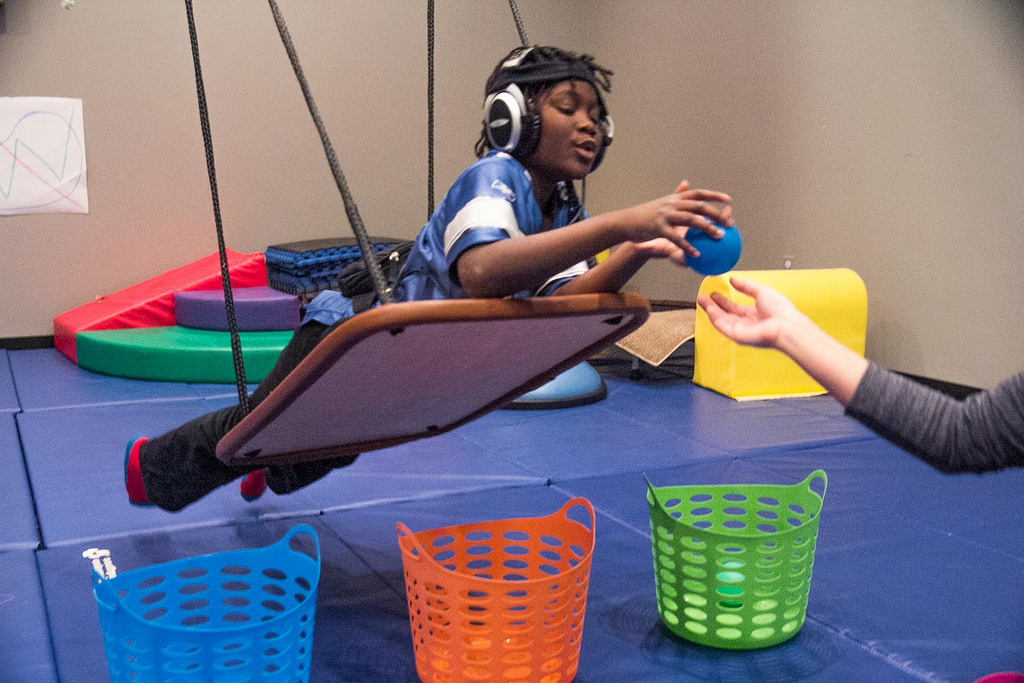
Occupational Therapy
Occupational therapy can help children with autism perform better in school and home environments. Parents who are referred to occupational therapy practitioners often have concerns about the behavioral and social development problems their children with autism display in these environments, and practitioners can assist with these issues.Occupational therapy services focus on enhancing participation in the performance of activities of daily living (e.g., feeding, dressing), instrumental activities of daily living (e.g., community mobility, safety procedures), education, work, leisure, play, and social participation. For an individual with [autism], occupational therapy services are defined according to the person’s needs and desired goals and priorities for participation.Occupational therapy services for individuals with [autism] include evaluation, intervention, and measurement of outcomes. Throughout the process, collaboration with the child or adult with autism, family, caregivers, teachers, and other supporters is essential to understanding the daily life experiences of the individual and those with whom he or she interacts. Occupational therapy services can focus on personal development, quality of life, and the needs of the family. – from The American Occupational Therapy Association
Speech-Language Therapy
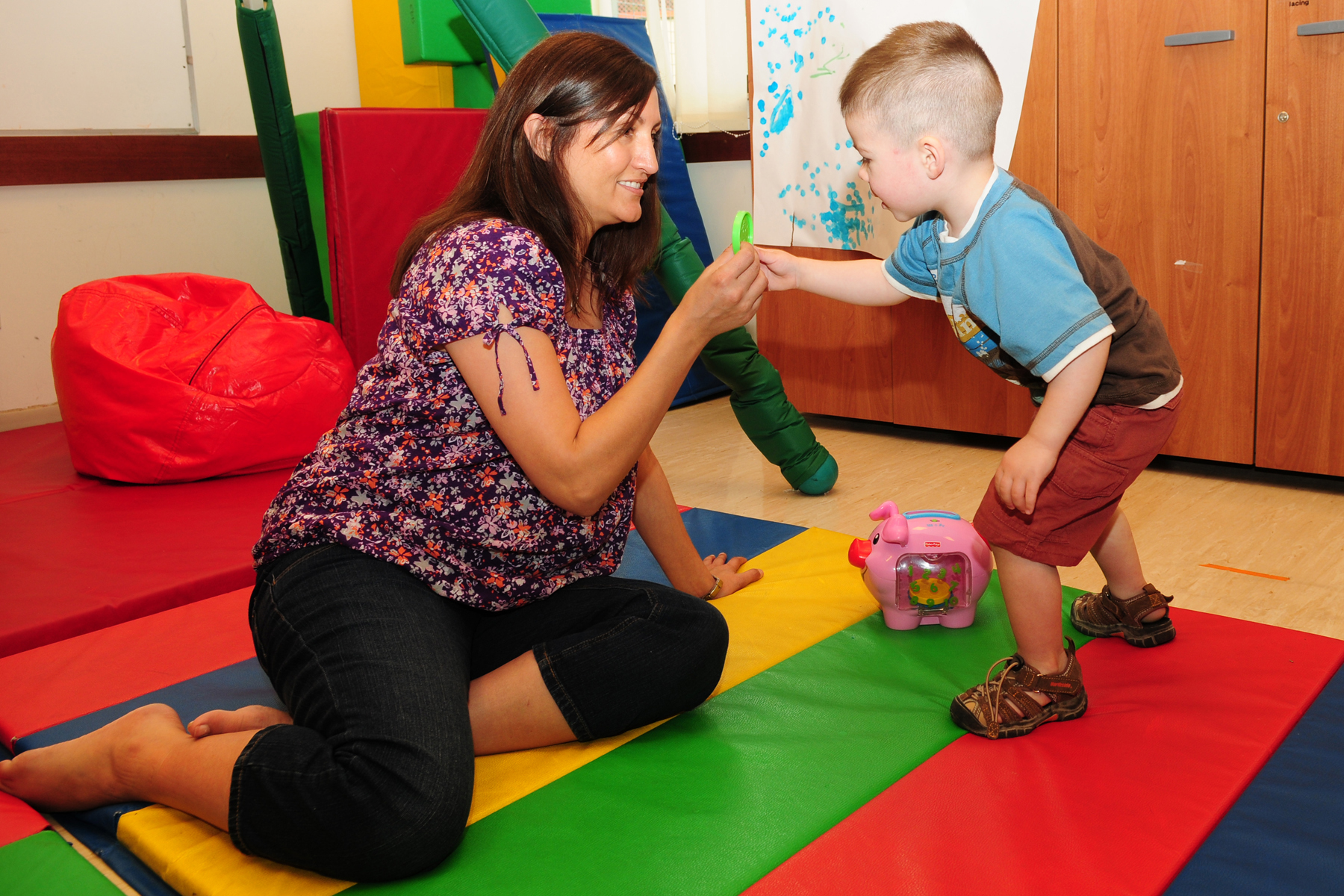
Speech-Language Therapy
An SLP (Speech-Language Pathologist) may work with your child at home, in the classroom, or in an office. Your child might work on some goals alone or in small groups. Small groups allow your child to practice skills with other children.An SLP will help your child understand, talk, read, and write. SLPs work with children on social skills too. They also work with children who don’t talk at all. An SLP may help your child:
- develop joint attention;
- play and get along with others;
- understand and use gestures to communicate;
- follow directions.
An SLP will help your child understand and use words. Your child may learn to
- ask and answer questions;
- ask for help;
- take turns in a conversation;
- start or stop a conversation.
SLPs also work on reading and writing. Your child may learn to
- look at books and tell stories;
- write letters, words, and sentences.
An SLP may use augmentative and alternative communication (AAC) with your child. AAC should be used at home and when you go out. It’s not just for school. AAC includes
- sign language;
- gestures;
- pictures, photos, objects, or videos;
- written words;
- computer, tablets, or other electronic devices.
Many children with autism can benefit from AAC. AAC may even help children learn to talk.
Children with autism may to like the way foods look, taste, or smell. They may not like how some foods feel in their mouth. Your child may
- refuse new foods;
- avoid foods with different textures, colors, or tastes;
- eat a limited number of foods.
An SLP can help your child accept new foods.
www.asha.org
The Greenspan Floortime Approach
The Greenspan Floortime approach is probably the most popular alternative to ABA.
What is the Greenspan Floortime approach?
Floortime is a Developmental, Individual, Relationship-based (DIR), model that enables clinicians, parents and educators to conduct a comprehensive assessment of an individual and develop a treatment program unique to them.
The Greenspan Floortime Approach is a system developed by the late Dr. Stanley Greenspan. Floortime meets children where they are and builds upon their strengths and abilities through creating a warm relationship and interacting. It challenges them to go further and to develop who they are rather than what their diagnosis says.
In Floortime, you use this time with your child to excite her interests, draw her to connect to you, and challenge her to be creative, curious, and spontaneous—all of which move her forward intellectually and emotionally. (As children get older, Floortime essentially morphs into an exciting, back-and-forth time of exploring the child’s ideas.)
For any age child, you do three things:
- Follow your child’s lead, i.e. enter the child’s world and join in their emotional flow;
- Challenge her to be creative and spontaneous; and
- Expand the action and interaction to include all or most of her senses and motor skills as well as different emotions.
As you do all this, while staying within her focus, you are helping her practice basic thinking skills: engagement, interaction, symbolic thinking and logical thinking. To master these skills requires using all these senses, emotions, and motor skills, as The Greenspan Floortime Approach explains.
Here is a great explanation from an autistic adult, Amethyst Schaber about the difference between Floortime and ABA
[edit January 2022: I don’t know why the video has been taken down. Whether it was intentionally removed or she simply no-longer endorses Floortime is unclear]
Some supporters would say that their child’s autism is so “SEVERE” that they cannot function without ABA intervention. Behaviors exhibited include constant meltdowns… Self-harm, fecal smearing (just like it sounds), screaming, physical violence, etc.
Some parents are afraid for their lives. Their children lash out and hurt others. The children grow older, bigger, and stronger and continue to lash out. In some cases, the police get involved and the children end up with involuntary commitment, facing criminal charges, or even injured or killed in extreme cases.
What can be done for these kids besides ABA therapy?
Here is an article from the Thinking Person’s Guide to Autism that compiles many different approaches to intervention for even “severe” behaviors besides ABA called “If Not ABA, then What?”
In it, the author encourages parents to seek out the CAUSE of the behaviors instead of looking only at changing the behavior.
“Sometimes aggression is the only way your child has to communicate that something is wrong. ABA might be able to stop the aggression, yes. But at what cost? Do you want your child to be trained to put up with pain and abuse? Of course you don’t! That was a ridiculous question. But it comes with an obvious answer: don’t use behaviorism to train your child out of aggression. Ferret out the source of the aggression and remedy it. It might be something in the environment, it might be the way someone is treating your child, it might be a health issue your child is struggling with. Whatever it is, play detective. Figure it out and help your child.”
Here is another excerpt:
Brenda Rothman offers some excellent advice for how to stay calm, how to respond to your child in distress, and how to address aggression with grace and love. You don’t need ABA for your child’s aggression. In fact, ABA is only likely to “work” in these instances by increasing but suppressing your child’s level of trauma and suffering. Whatever caused your child to suffer so much that they lost control is still causing your child to suffer, but if the ABA has done what it set out to do, your child has lost the only channel of communication available to them for expressing their pain and suffering in hopes of getting help with their distress.
Don’t take away your child’s voice; take away their suffering. ABA is a cruel response to aggressive behavior. Meet that behavior with love, calm, support, and an investigative search for the source of your child’s struggle instead. Learn why your child is getting so stressed out that they are frightening the people around them, and help make your child’s life calmer, safer, and happier. That is what you were hoping ABA would do, but I am here to tell you that ABA cannot do that. It is your role as a loving parent and you don’t need a behaviorist. You just need the love and compassion you already have for your beautiful child. Dealing with aggression really is a situation in life where love conquers all. Go forth now and vanquish suffering with curiosity, compassion, and calmness.”
NEXT: Is ABA right for you?
So knowing all of this—knowing the history behind ABA—knowing all the abuse autistics have suffered at the hands of “behaviorists” and ABA “therapists,” and knowing that there are other options besides ABA, what reasons would we have for even considering ABA?
In order for you to make an informed decision, I have extensively reviewed all the harmful possibilities of ABA and what the opposition has to say about it, simply so you are aware.
In my next post I will look at what the medical field, parents, and other Autistics have to say about ABA. I will leave it up to you to decide whether it is right for you or not.
Steve Silberman
www.slate.com
Maxfield Sparrow
www.unstrangemind.com
Shannon Des Roches Rosa
www.thinkingautismguide.com
Jamie Pacton
www.parents.com
Margalit Fox
www.nytimes.com
Michelle Sutton
michellesuttonwrites.com
Floortime Foundation
www.Floortime.org
Stanley Greenspan
www.StanleyGreenspan.com
sociallyanxiousadvocate.wordpress.com
madasbirdsblog.wordpress.com
www.ncbi.nlm.nih.gov
neurodiversity.com
www.autismtreatmentcenter.org
juststimming.wordpress.com
ink-and-daggers.tumblr.com
